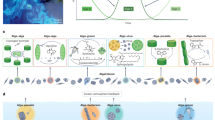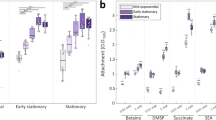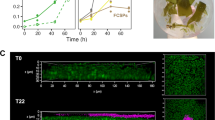Abstract
Like most eukaryotes, brown algae live in association with bacterial communities that frequently have beneficial effects on their development. Ectocarpus is a genus of small filamentous brown algae, which comprises a strain that has recently colonized freshwater, a rare transition in this lineage. We generated an inventory of bacteria in Ectocarpus cultures and examined the effect they have on acclimation to an environmental change, that is, the transition from seawater to freshwater medium. Our results demonstrate that Ectocarpus depends on bacteria for this transition: cultures that have been deprived of their associated microbiome do not survive a transfer to freshwater, but restoring their microflora also restores the capacity to acclimate to this change. Furthermore, the transition between the two culture media strongly affects the bacterial community composition. Examining a range of other closely related algal strains, we observed that the presence of two bacterial operational taxonomic units correlated significantly with an increase in low salinity tolerance of the algal culture. Despite differences in the community composition, no indications were found for functional differences in the bacterial metagenomes predicted to be associated with algae in the salinities tested, suggesting functional redundancy in the associated bacterial community. Our study provides an example of how microbial communities may impact the acclimation and physiological response of algae to different environments, and thus possibly act as facilitators of speciation. It paves the way for functional examinations of the underlying host–microbe interactions, both in controlled laboratory and natural conditions.
Similar content being viewed by others
Log in or create a free account to read this content
Gain free access to this article, as well as selected content from this journal and more on nature.com
or
Accession codes
References
Benjamini Y, Hochberg Y . (1995). Controlling the false discovery rate—a practical and powerful approach to multiple testing. J R Stat Soc Ser B 57: 289–300.
Billoud B, Nehr Z, Le Bail A, Charrier B . (2014). Computational prediction and experimental validation of microRNAs in the brown alga Ectocarpus siliculosus. Nucleic Acids Res 42: 417–429.
Bold HC, Wynne MJ . (1985) Introduction to the Algae: Structure and Reproduction, 2nd ed. Prentice-Hall: Englewood Cliffs, New Jersey, USA.
Bolton JJ . (1983). Ecoclinal variation in Ectocarpus siliculosus (Phaeophyceae) with respect to temperature growth optima and survival limits. Mar Biol 73: 131–138.
Burke C, Thomas T, Lewis M, Steinberg P, Kjelleberg S . (2011). Composition, uniqueness and variability of the epiphytic bacterial community of the green alga Ulva australis. ISME J 5: 590–600.
Caporaso JG, Lauber CL, Walters WA, Berg-Lyons D, Huntley J, Fierer N et al. (2012). Ultra-high-throughput microbial community analysis on the Illumina HiSeq and MiSeq platforms. ISME J 6: 1621–1624.
Charrier B, Coelho SM, Le Bail A, Tonon T, Michel G, Potin P et al. (2008). Development and physiology of the brown alga Ectocarpus siliculosus: two centuries of research. New Phytol 177: 319–332.
Chisholm JRM, Dauga C, Ageron E, Grimont PAD, Jaubert JM . (1996). ‘Roots’ in mixotrophic algae. Nature 381: 382–382.
Cock JM, Peters AF, Coelho SM . (2011). Brown algae. Curr Biol 21: R573–R575.
Cock JM, Sterck L, Rouzé P, Scornet D, Allen AE, Amoutzias G et al. (2010). The Ectocarpus genome and the independent evolution of multicellularity in brown algae. Nature 465: 617–621.
Coulthurst SJ . (2013). The Type VI secretion system - a widespread and versatile cell targeting system. Res Microbiol 164: 640–654.
Croft MT, Warren MJ, Smith AG . (2006). Algae need their vitamins. Eukaryot Cell 5: 1175–1183.
Deligianni E, Pattison S, Berrar D, Ternan NG, Haylock RW, Moore JE et al. (2010). Pseudomonas aeruginosa cystic fibrosis isolates of similar RAPD genotype exhibit diversity in biofilm forming ability in vitro. BMC Microbiol 10: 38.
Dittami SM, Barbeyron T, Boyen C, Cambefort J, Collet G, Delage L et al. (2014a). Genome and metabolic network of ‘Candidatus Phaeomarinobacter ectocarpi’ Ec32, a new candidate genus of Alphaproteobacteria frequently associated with brown algae. Front Genet 5: 241.
Dittami SM, Eveillard D, Tonon T . (2014b). A metabolic approach to study algal-bacterial interactions in changing environments. Mol Ecol 23: 1656–1660.
Dittami SM, Gravot A, Goulitquer S, Rousvoal S, Peters AF, Bouchereau A et al. (2012). Towards deciphering dynamic changes and evolutionary mechanisms involved in the adaptation to low salinities in Ectocarpus (brown algae). Plant J 71: 366–377.
Dittami SM, Proux C, Rousvoal S, Peters AF, Cock JM, Coppee J-Y et al. (2011). Microarray estimation of genomic inter-strain variability in the genus Ectocarpus (Phaeophyceae). BMC Mol Biol 12: 2.
Dittami SM, Scornet D, Petit J-L, Ségurens B, Da Silva C, Corre E et al. (2009). Global expression analysis of the brown alga Ectocarpus siliculosus (Phaeophyceae) reveals large-scale reprogramming of the transcriptome in response to abiotic stress. Genome Biol 10: R66.
Egan S, Harder T, Burke C, Steinberg P, Kjelleberg S, Thomas T . (2013). The seaweed holobiont: understanding seaweed-bacteria interactions. FEMS Microbiol Rev 37: 462–476.
Goecke F, Labes A, Wiese J, Imhoff J . (2010). Chemical interactions between marine macroalgae and bacteria. Mar Ecol Prog Ser 409: 267–299.
Guttenplan SB, Kearns DB . (2013). Regulation of flagellar motility during biofilm formation. FEMS Microbiol Rev 37: 849–871.
Hammer Ø, Harper D, Ryan P . (2001). PAST: Paleontological statistics software package for education and data analysis. Palaeontolia Electron 4.
Hollants J, Leliaert F, De Clerck O, Willems A . (2013). What we can learn from sushi: a review on seaweed-bacterial associations. FEMS Microbiol Ecol 83: 1–16.
Hubbell SP . (2001) The Unified Neutral Theory of Biodiversity and Biogeography (MPB-32). Princeton University Press: Princeton, NJ, USA.
Langille MGI, Zaneveld J, Caporaso JG, McDonald D, Knights D, Reyes JA et al. (2013). Predictive functional profiling of microbial communities using 16S rRNA marker gene sequences. Nat Biotechnol 31: 814–821.
Lee C, Bell M . (1999). Causes and consequences of recent freshwater invasions by saltwater animals. Trends Ecol Evol 14: 284–288.
Logares R, Bråte J, Bertilsson S, Clasen JL, Shalchian-Tabrizi K, Rengefors K . (2009). Infrequent marine-freshwater transitions in the microbial world. Trends Microbiol 17: 414–422.
Magurran AE . (2004) Measuring Biological Diversity. Wiley: Oxford, UK.
Maignien L, DeForce EA, Chafee ME, Eren AM, Simmons SL . (2014). Ecological succession and stochastic variation in the assembly of Arabidopsis thaliana phyllosphere communities. MBio 5: e00682–13.
Meslet-Cladière L, Delage L, Leroux CJ, Goulitquer S, Leblanc C, Creis E et al. (2013). Structure/Function analysis of a type III polyketide synthase in the brown alga Ectocarpus siliculosus reveals a biochemical pathway in phlorotannin monomer biosynthesis. Plant Cell 25: 3089–3103.
Oksanen J, Blanchet FG, Kindt R, Legendre P, Minchin PR, O’Hara RB et al. (2013), Vegan: Community Ecology Package.
Parks DH, Beiko RG . (2010). Identifying biologically relevant differences between metagenomic communities. Bioinformatics 26: 715–721.
Pedersén M . (1968). Ectocarpus fasciculatus: marine brown alga requiring kinetin. Nature 218: 776–776.
Pedersén M . (1973). Identification of a cytokinin, 6-(3 methyl-2-butenylamino) purine, in sea water and the effect of cytokinins on brown algae. Physiol Plant 28: 101–105.
Peters AF, Marie D, Scornet D, Kloareg B, Cock JM . (2004). Proposal of Ectocarpus siliculosus (Ectocarpales, Phaeophyceae) as a model organism for brown algal genetics and genomics. J Phycol 40: 1079–1088.
Peterson AT, Soberón J, Pearson RG, Anderson RP, Martínez-Meyer E, Nakamura M et al. (2011) Ecological Niches and Geographic Distributions (MPB-49). Princeton University Press: Princeton, NJ, USA.
Pommier T, Canbäck B, Riemann L, Boström KH, Simu K, Lundberg P et al. (2007). Global patterns of diversity and community structure in marine bacterioplankton. Mol Ecol 16: 867–880.
R Core Team. (2014), R: A language and environment for statistical computing.
Ritter A, Ubertini M, Romac S, Gaillard F, Delage L, Mann A et al. (2010). Copper stress proteomics highlights local adaptation of two strains of the model brown alga Ectocarpus siliculosus. Proteomics 10: 2074–2088.
Sale PF . (1979). Recruitment, loss and coexistence in a guild of territorial coral reef fishes. Oecologia 42: 159–177.
Schloss PD, Westcott SL, Ryabin T, Hall JR, Hartmann M, Hollister EB et al. (2009). Introducing mothur: open-source, platform-independent, community-supported software for describing and comparing microbial communities. Appl Environ Microbiol 75: 7537–7541.
Smoot ME, Ono K, Ruscheinski J, Wang P-L, Ideker T . (2011). Cytoscape 2.8: new features for data integration and network visualization. Bioinformatics 27: 431–432.
Starr RC, Zeikus JA . (1993). Utex - the culture collection of algae at the University of Texas at Austin: 1993 list of cultures. J Phycol 29: 1–106.
Staufenberger T, Thiel V, Wiese J, Imhoff JF . (2008). Phylogenetic analysis of bacteria associated with Laminaria saccharina. FEMS Microbiol Ecol 64: 65–77.
Tatarenkov A, Bergström L, Jönsson RB, Serrão EA, Kautsky L, Johannesson K . (2005). Intriguing asexual life in marginal populations of the brown seaweed Fucus vesiculosus. Mol Ecol 14: 647–651.
Tonon T, Eveillard D, Prigent S, Bourdon J, Potin P, Boyen C et al. (2011). Toward systems biology in brown algae to explore acclimation and adaptation to the shore environment. Omics 15: 883–892.
Torode TA, Marcus SE, Jam M, Tonon T, Blackburn RS, Hervé C et al. (2015). Monoclonal antibodies directed to fucoidan preparations from brown algae. PLoS One 10: e0118366.
Wahl M, Goecke F, Labes A, Dobretsov S, Weinberger F . (2012). The second skin: ecological role of epibiotic biofilms on marine organisms. Front Microbiol 3: 292.
West J, Kraft G . (1996). Ectocarpus siliculosus (Dillwyn) Lyngb. from Hopkins River Falls, Victoria–the first record of a freshwater brown alga in Australia. Muelleria 9: 29–33.
Zilber-Rosenberg I, Rosenberg E . (2008). Role of microorganisms in the evolution of animals and plants: the hologenome theory of evolution. FEMS Microbiol Rev 32: 723–735.
Zinger L, Amaral-Zettler LA, Fuhrman JA, Horner-Devine MC, Huse SM, Welch DBM et al. (2011). Global patterns of bacterial beta-diversity in seafloor and seawater ecosystems. PLoS One 6: e24570.
Zobell CE . (1941). Studies on marine bacteria. I. The cultural requirements of heterotrophic aerobes. J Mar Res 4: 42.
Acknowledgements
We are grateful to Catherine Leblanc, Christian Jeanthon, Dominique Davoult, Philippe Potin, Elianne Sirnæs Egge and Tristan Barbeyron for helpful advice on the experimental setup and analysis. We also thank Ludovic Delage for providing Zobellia galactanivorans DNA, Akira Peters (BEZHIN ROSKO) for providing algal strains, Declan Schroeder for allowing us to use the two South African algal strains, Laurence Dartevelle for performing antibiotic treatments on strain 371, Jonas Collén for critical reading of the manuscript, and the Biogenouest Genomics and Genomer platform core facility for technical support. This work benefited from the support of the French Government via the National Research Agency investment expenditure program IDEALG (ANR-10-BTBR-02-04) and additional support came from the region Brittany via the SAD (Stratégie d’Attractivité Durable) project COGEBRAL.
Author information
Authors and Affiliations
Corresponding author
Ethics declarations
Competing interests
The authors declare no conflict of interest.
Additional information
Supplementary Information accompanies this paper on The ISME Journal website
Rights and permissions
About this article
Cite this article
Dittami, S., Duboscq-Bidot, L., Perennou, M. et al. Host–microbe interactions as a driver of acclimation to salinity gradients in brown algal cultures. ISME J 10, 51–63 (2016). https://doi.org/10.1038/ismej.2015.104
Received:
Revised:
Accepted:
Published:
Issue date:
DOI: https://doi.org/10.1038/ismej.2015.104
This article is cited by
-
Disentangling direct vs indirect effects of microbiome manipulations in a habitat-forming marine holobiont
npj Biofilms and Microbiomes (2024)
-
Mitigation of photoinhibition in Isochrysis galbana by the construction of microalgal-bacterial consortia
Journal of Applied Phycology (2022)
-
Bacterial diversity in different outdoor pilot plant photobioreactor types during production of the microalga Nannochloropsis sp. CCAP211/78
Applied Microbiology and Biotechnology (2022)
-
Integration of spatio-temporal variations of surface metabolomes and epibacterial communities highlights the importance of copper stress as a major factor shaping host-microbiota interactions within a Mediterranean seaweed holobiont
Microbiome (2021)
-
Host specificity of microbiome assembly and its fitness effects in phytoplankton
The ISME Journal (2021)



